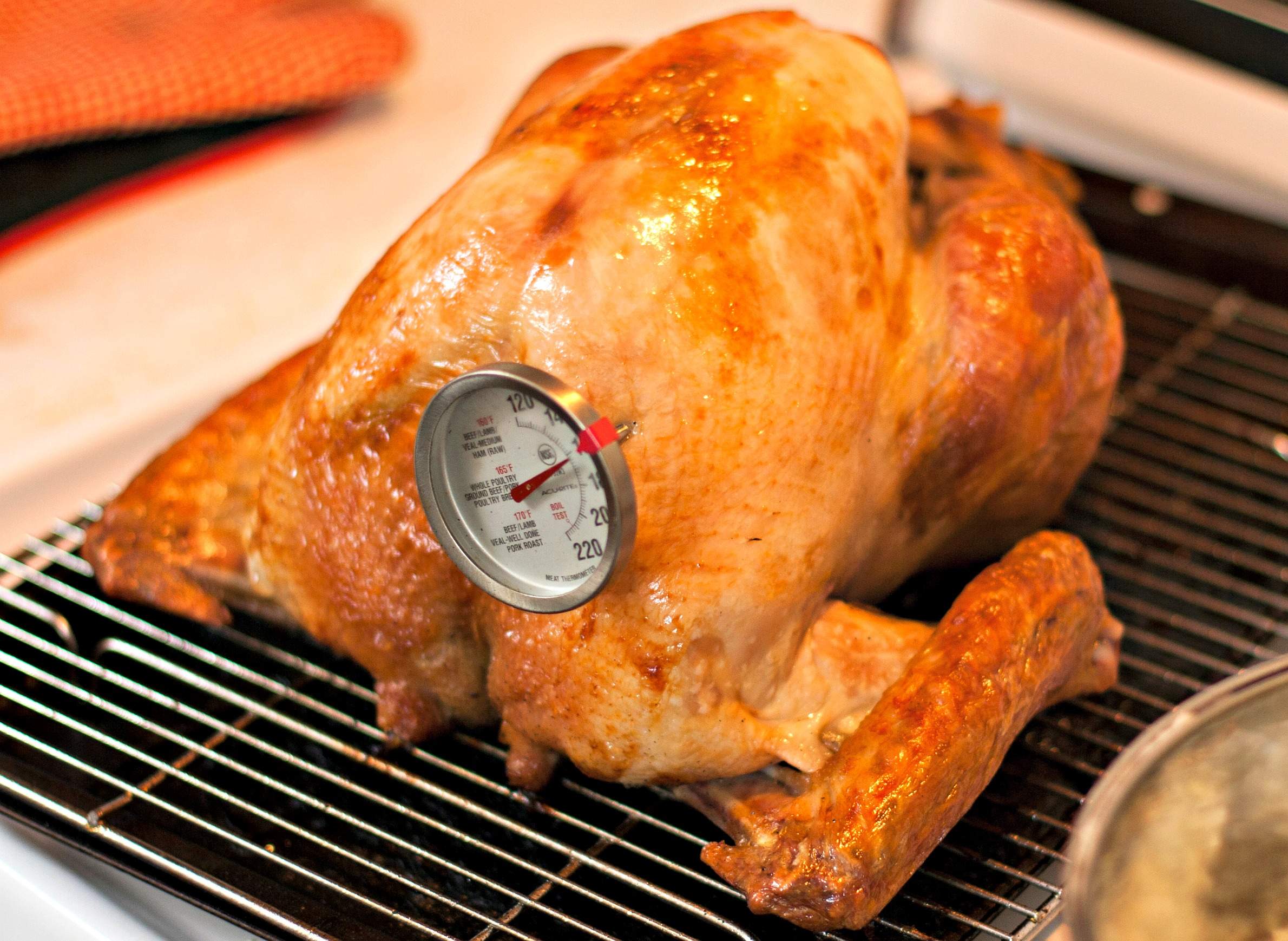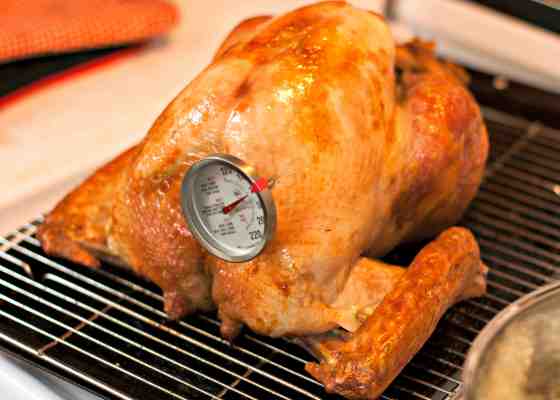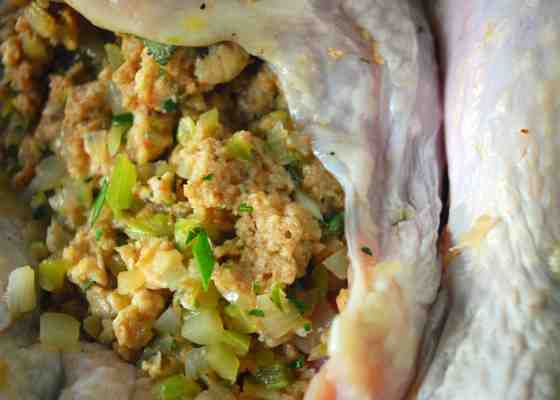
Roasting A Turkey Requires Some TLC

Thanksgiving and the holiday season brings families together to share a meal that often centers on roast turkey and all the fixings. But to avoid spreading foodborne illness, appropriate steps for roasting the bird should be taken.
To decide how large a turkey to buy, allow for one pound per person. A fresh turkey should be purchased only one to two days before it will be cooked. It should be stored on a refrigerator's bottom shelf in a pan or tray, which will catch any juices that may leak.
A frozen turkey can be safely roasted without thawing it. However, the overall cooking time takes at least 50 percent longer than recommended for a fully thawed turkey, not including the time to thaw the bird. Cooking a frozen turkey can reduce the number of tasks and enable the cook to be prepared to focus on guests when they arrive, but it does not allow for cooking stuffing in the bird or for taking flavor-enhancing steps such as brining. Regardless of whether a turkey is thawed prior to roasting, the quality of the meat will be the same.
To roast a frozen turkey, the wrapping and any gravy packet should be removed. The bird should be set in a pan on a rack in an oven pre-heated to at least 325 degrees Fahrenheit. After it has thawed sufficiently in the oven — for about two to three hours — the turkey should be taken from the oven so the giblets and neck can be removed from inside the body cavity. The remaining time required for cooking will depend on the size of the bird. Four and a half to five hours will be needed to cook a 12- to 13-pound frozen turkey from the frozen state; more time is necessary for larger birds.
Frozen turkey should not be thawed until the time comes to cook it so that bacteria that were frozen with the turkey do not begin to grow again and cause illness among dinner guests. The time needed to thaw a turkey depends on the method and size of the turkey. Turkeys can be safely thawed in the refrigerator, in cold water or in a microwave oven.
Thawing a turkey
In the refrigerator (40 degrees Fahrenheit or colder): The turkey should be kept in its original wrapper and set on a tray or pan to catch dripping liquid as it thaws in a refrigerator. Once it is completely thawed, the turkey may be stored in the refrigerator one to two more days before it must be cooked. Four to five days are needed to thaw an average 20-pound turkey in the refrigerator.
In cold water: Ideally, the turkey is kept in its original wrapping, which should be checked to ensure it is secure so water cannot leak into the package. The turkey should be completely submerged in cold water (60-65 degrees Fahrenheit), which should be changed every 30 minutes as it gradually warms. Turkeys thawed in cold water should be cooked immediately after thawing. They should not be refrigerated or refrozen.
In the microwave oven: The microwave's owner's manual should state the size of the largest turkey that will fit inside the appliance, the required minutes per pound for defrosting and the power level to use. All outside wrapping should be removed and the turkey should be placed on a microwave-safe dish to catch juices that may leak. Turkey thawed by microwave should be cooked immediately and not be refrozen or refrigerated.
Roasting a turkey
Turkeys — or other meat— should not be rinsed for cooking; this practice only spreads germs. Paper towels should be used to gently remove pin feathers or blood. Direct contact with a raw bird or its juices can spread bacteria and foodborne illness if the cook then touches other surfaces and food.
The oven’s temperature should be no lower than 325 degrees Fahrenheit. The turkey should be placed on a rack in a shallow roasting pan.
For optimum food safety, stuffing a turkey directly is not recommended. Cooking the stuffing separately in a casserole dish also helps to cook the turkey evenly. The stuffing's internal temperature should reach a minimum of 165 degrees Fahrenheit to be safe, ideally checked with a food thermometer.
If the turkey is to be stuffed, the ingredients can be prepared ahead of time; however, wet and dry ingredients should be kept separate. All wet ingredients (butter or margarine, cooked celery and onions, broth and so on) should be chilled and then mixed with the dry ingredients just before the neck and body cavities are loosely filled. The turkey should then be cooked immediately. A food thermometer should be used to make sure the center of the stuffing and the turkey reach a safe minimum internal temperature of 165 degrees Fahrenheit.
To kill bacteria that could make people sick, the cook should always wash with soap and water her or his hands, utensils, the sink and anything else that comes in contact with raw turkey and its juices.
If a roasting pan does not have a lid, a tent of heavy-duty aluminum foil can be placed over the turkey for the first one to 1.5 hours. This cover allows for maximum heat circulation, keeps the turkey moist and reduces oven splatter. To prevent over-browning, fresh foil may be placed over the turkey after it reaches the desired color.
A whole roast turkey is safe when cooked to a minimum internal temperature of 165 degrees Fahrenheit as measured with a food thermometer. The internal temperature should be checked at the innermost part of the thigh and wing and the thickest part of the breast. For safety's sake, the turkey's pop-up doneness indicator should not be relied on.
For better taste and easier carving, the roast turkey should stand and rest for 20 minutes before being carved to allow juices to set. All stuffing should be removed from the turkey cavities before carving.
Cooking Thanksgiving dinner and other holiday meals with their many dishes and high expectations can be complex and sometimes stressful. The U.S. Department of Health and Human Services offers information on how to plan the Thanksgiving meal and prepare the turkey. Questions also can be directed in English and Spanish to the U.S. Department of Agriculture's Food Safety and Inspection Services' "Ask Karen" service.
Of course, there are many ways to cook turkey for holiday meals, and more people are trying their hand at deep-frying the bird, which offers its own host of safety challenges. But for people looking for the traditional roast-turkey experience, the preparation and cooking process is relatively simple.
Barbara Ingham is a food safety specialist with the University of Wisconsin-Extension.






